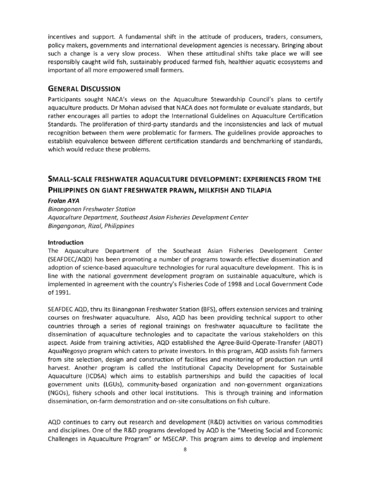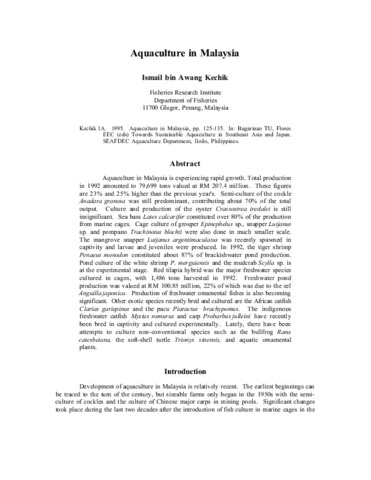Assessment of tilapia-freshwater prawn co-culture schemes in tanks and lake-based cages for increased farm production
- Global styles
- MLA
- Vancouver
- Elsevier - Harvard
- APA
- Help

Download URL
www.mdpi.comDate
2021-12-08Page views
326ASFA keyword
Metadata
Show full item recordCited times in Scopus
- Citations
- CrossRef - Citation Indexes: 3
- Scopus - Citation Indexes: 5
- Captures
- Mendeley - Readers: 11
- Social Media
- Facebook - Shares, Likes & Comments: 10
Share
Abstract
The technical viability of tilapia (I-ExCEL strain Nile or red) and giant freshwater prawn (GFP) co-culture in cages-within-tanks was evaluated while appropriate feeding protocols for tilapia-GFP co-culture in cages in a eutrophic lake were determined. Specifically, production parameters in all test species grown for five months in tank co-culture (where only tilapias were fed) were compared, while the best feeding protocol from among the following treatments: (a) Tfed—fed tilapias; (b) GFPfed—fed prawns and (c) T-GFPfed—both species fed, were defined. I-ExCEL Nile tilapias grew faster in tank co-culture whether reared singly or otherwise. However, red tilapia-GFP tank co-culture gave the best results considering key production traits in all test species (red tilapia —2.52%/day specific growth rate or SGR, 83.3% survival; GFP—1.17%/day SGR, 72.85% survival). Lake-based co-culture was technically feasible at stocking densities of 12.5/m2 for tilapia and 2.4 to 4/m2 for prawns even when only tilapias were fed; prawns grew to desired marketable sizes by thriving mainly on detritus and natural food organisms in the lake. However, further refinements can still be made to optimise the co-culture schemes to make them more sustainable and provide artisanal fish farmers options in increasing farm yields through multi-species aquaculture.
Description
Supplementary Materials
The following are available online at https://www.mdpi.com/article/10.3390/su132413574/s1, Figure S1: Growth (SGR) of the different freshwater aquatic species (Nile tilapia, red tilapias, prawns) reared for five months using the cage-in-tank monoculture and/or co-culture schemes, Figure S2: Survival of all the freshwater aquatic species reared in the cage-in-tank monoculture and/or co-culture systems, Figure S3: Specific growth rates of the tilapias and prawns reared in lake-based co-culture systems using different feeding schemes, Figure S4: Survival of the co-cultured tilapias and prawns in the lake-based cages using different feeding protocols, Figure S5: Results of plankton monitoring in the lake facility, wet season run, Figure S6: Results of plankton monitoring in the lake facility, dry season runSuggested Citation
Romana-Eguia, M. R. R., Rutaquio, M. P., Gutierrez, R. C., & Salayo, N. D. (2021). Assessment of tilapia-freshwater prawn co-culture schemes in tanks and lake-based cages for increased farm production. Sustainability , 13(24), 13574. https://doi.org/10.3390/su132413574
Type
ArticleISSN
2071-1050Collections
- Journal Articles [1247]
The following license files are associated with this item:
Related items
Showing items related by title, author, creator and subject.
-
Small-scale freshwater aquaculture development: Experiences from the Philippines on giant freshwater prawn, milkfish and tilapia
The Aquaculture Department of the Southeast Asian Fisheries Development Center (SEAFDEC/AQD) has been promoting a number of programs towards effective dissemination and adoption of science-based aquaculture technologies ... -
Effect of shrimp biomass and feeding on the anti-Vibrio harveyi activity of Tilapia sp. in a simulated shrimp–tilapia polyculture system
The efficiency of Tilapia hornorum to control luminous bacteria in a simulated shrimp farm environment has been reported. However, the effects of different factors such as feed input and the shrimp biomass were not taken ...1212 Total citations3 Recent citations1.03 Field Citation Ration/a Relative Citation Ratio
-
Aquaculture in Malaysia
Kechik, Ismail bin Awang. (Aquaculture Department, Southeast Asian Fisheries Development Center, 1995)Aquaculture in Malaysia is experiencing rapid growth. Total production in 1992 amounted to 79,699 tons valued at RM 207.4 million. These figures are 23% and 25% higher than the previous year's. Semi-culture of the cockle ...







